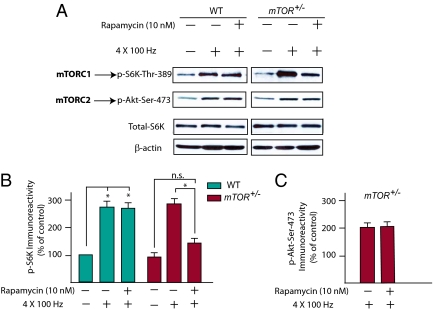Fig. 2.
A low concentration of rapamycin specifically blocks high-frequency-induced mTORC1 activity, but not mTORC2 activity, only in mTOR+/− mice. (A) CA1-hippocampal slices from WT and mTOR+/− mice were either untetanized controls (stimulated at 0.033 Hz) or tetanized by four trains of 100 Hz (at 5-min intervals) in the presence or absence of a low concentration of rapamycin (10 nM). Extracts of CA1 regions were prepared 30 min after stimulation, and the phosphorylation of S6K (Threonine-389) and Akt (Serine-473) was determined by Western blotting. (B and C) Quantification of normalized phospho-S6K-Thr-389 (B), n = 4 mice (8 slices) per condition; and phosphor-Akt-Ser473 (C), n = 4 mice (8 slices) per conditions (*P < 0.05).

